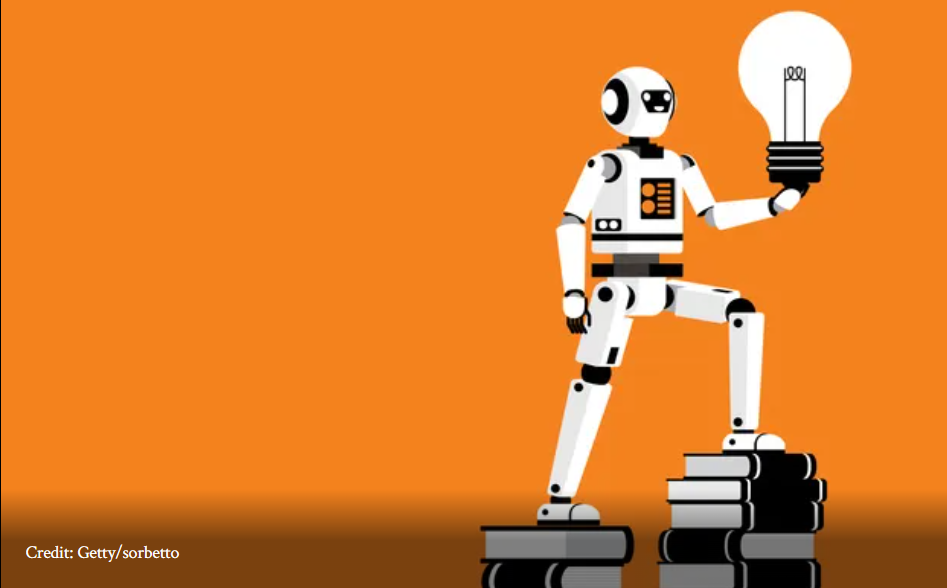This new school year, Jordan Clayton-Taylor, a Chicago high school English teacher, said she’s going old-school. When it comes time to write an essay, her students will have to close the Chromebooks and use pen and paper instead.
It’s a preemptive strike of sorts: Clayton-Taylor is instituting the policy after realizing last year that students were copying and pasting prompts into ChatGPT, then turning in the result as though it were their own work. And just as teachers insisted that cheating hurts the cheater, Clayton-Taylor worries that artificial intelligence chatbots are eroding students’ ability to think for themselves.
RELATED: Teachers Union’s AI Deal Raises Questions—and Concerns
“It definitely does impact students’ critical thinking skills,” Clayton-Taylor says. “They’re not able to think on their own. The purpose of English is for you to be able to formulate your own idea.”
Since emerging as a breakthrough educational technology in recent years, AI has been hailed as a savior for Black students, a low-cost way to personalize learning and tutoring, tackle learning loss, and level the playing field between underfunded Black schools and affluent white ones. But besides its propensity for built-in bias, teachers and education experts worry that, when it comes to student learning, original thinking, and knowledge retention, AI can be more of a hindrance than a help.
As more and more young teens are starting ChatGPT to help with their schoolwork, some educators are grappling with how to teach in a learning environment where artificial intelligence tools like chatbots are so accessible, spewing out answers and complete essays within seconds.
AI and Critical Thinking Skills
A recent MIT study, for example, found that people who copied and pasted a prompt in ChatGPT in order to write a complete essay for the SAT test had lower brain engagement. The study also found that, much like AI’s own output, their work lacked originality and was bland.
Devery Rodgers, who teaches educational technology at California State University, says that with every new technology, like the calculator or the Google search engine, critics’ knee-jerk reaction is to condemn it for eroding critical thinking skills. When OpenAI launched ChatGPT in 2022, the field of AI research had already been around for nearly 70 years.
What really matters, she says, is how the technology is applied.
“There is a way to learn and do good with it, just like there’s a way to learn and do evil with it,” Rodgers says. What’s important with AI, she says, is for teachers to engage with the technology and help their students become good digital citizens rather than burying their heads in the sand.
“Your part is to learn it yourself,” Rodgers says, referring to teachers. “The kids are always going to learn faster than us, because we have adult responsibilities, and they don’t. They will always play with it a whole lot more, and that’s how you learn.”
“Woke AI”
Then there are the biases that come with AI. The federal government recently issued an executive order to prevent “woke AI,” emphasizing that AI that uses “DEI” is “pervasive” and “destructive”.
Still, Rodgers encouraged teachers to understand and account for biases when they use ChatGPT and other generative AI language models to personalize learning and tutoring.
While a quarter of U.S. teachers say AI tools do more harm than good in K-12 education, some believe that they have to thoroughly understand AI in order to teach students best practices on how to use it.
Chatbots do a disservice to Black students in particular.
Indeed, Clayton-Taylor said she feels responsible for teaching her students how to use it as a tool: “I’m not just going to pick up a hammer and start using it.”
She notices that when her students stop relying on AI as a crutch, they tend to question their own writing and lack confidence in their abilities. Chatbots do a disservice to Black students in particular.
“The idea of perfection does not look like us,” Clayton-Taylor says. “It does not sound like us. It limits us. I’m very strong on instilling in our kids like you are perfect the way you are. You just have to believe in yourself.”
In Shannon Singleton’s classroom, students will be using their Chromebooks, but she’ll use software, GoGuardian, to monitor their work and keep them from improperly taking an AI shortcut.
“They will cheat,” the veteran Northwest Indiana high school geography, economics, and U.S. government teacher says. “Now that there’s AI, they can just put the essay prompt in it and it spits it out. I think having kids write at home isn’t going to be as successful as it has been in the past. The biggest thing is teaching kids that it’s not about the grade, but it’s about wanting to learn.”


